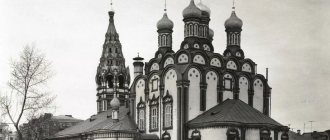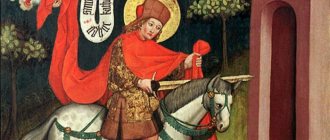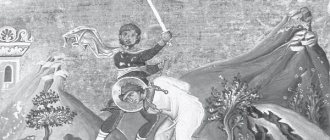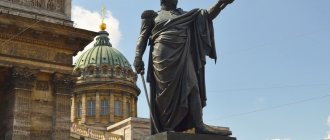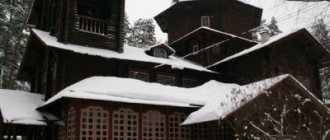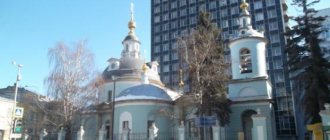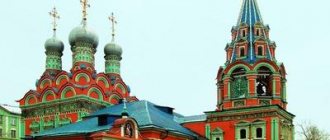Mir
Russia Moscow Church of St. Martin the Confessor (Moscow) Map loading in progress...
{"format":"leaflet","minzoom":false,"maxzoom":false,"limit":50,"offset":0,"link":"all","sort":[""], "order":[],"headers":"show","mainlabel":"","intro":"","outro":"","searchlabel":"\u2026 \u0441\u043b\u0435\ u0434\u0443\u044e\u0449\u0438\u0435 \u0440\u0435\u0437\u0443\u043b\u044c\u0442\u0430\u0442\u044b","default":"","import-annotation":false,"width ":"auto","height":"350px","centre":{"text":"","title":"""link":"""lat":55.7433300000000002683009370230138301849365234375,"lon": 37.66028000000000020008883439004421234130859375,"icon":""},"title":"","label":"","icon":"","lines":[],"polygons":[], "circles":[ ],"rectangles":[],"copycoords":false,"static":false,"zoom":8,"defzoom":14,"layers":["OpenStreetMap"],"image layers":[] ,"overlays":[],"resizable":false,"fullscreen":true,"scrollwheelzoom":true,"cluster":false,"clustermaxzoom":9,"clusterzoomonclick":true,"clustermaxradius":80, "clusterspiderfy":true,"geojson":"","clicktarget":"","showtitle":true,"hidenamespace":false,"template":"","userparam":"","activeicon": "","pagelabel":false,"ajaxcoordproperty":"","ajaxquery":"","locations":[{"text":"\u003Cb\u003E\u003Ca href=\"/palomnik/%D0% A6%D0%B5%D1%80%D0%BA%D0%BE%D0%B2%D1%8C_%D1%81%D0%B2%D1%8F%D1%82%D0%B8%D1%82% D0%B5%D0%BB%D1%8F_%D0%9C%D0%B0%D1%80%D1%82%D0%B8%D0%BD%D0%B0_%D0%98%D1%81%D0% BF%D0%BE%D0%B2%D0%B5%D0%B4%D0%BD%D0%B8%D0%BA%D0%B0_(%D0%9C%D0%BE%D1%81%D0%BA %D0%b2%d0%b0) \ "title = \" \ u0426 \ u0435 \ u0440 \ u043a \ u043e \ u0432 \ u04441 \ u0432 \ u0444f \ u0442 \ u0438 \ u04442 \ u0435 \ u0435 \ u0435 \ u0435 \ u0435 \ u0435 \ u0435 \ u0435 \ u0435 43b \ U044F \ U041C \ u0430\u0440\u0442\u0438\u043d\u0430 \u0418\u0441\u043f\u043e\u0432\u0435\u0434\u043d\u0438\u043a\u0430 (\u041c\u043e\u0441\u0 43a\u0432\u0430)\»\ u003E\u0426\u0435\u0440\u043a\u043e\u0432\u044c \u0441\u0432\u044f\u0442\u0438\u0442\u0435\u043b\u044f \u041c\u0430\u0440\u0 442\u0438\u043d\u0430\u0418\ u0441\u043f\u043e\u0432\u0435\u0434\u043d\u0438\u043a\u0430 (\u041c\u043e\u0441\u043a\u0432\u0430)\u003C/a\u003E\u003C/b\u003 E\u003Chr /\u003E \u003Ca href=\"/palomnik/%D0%A1%D0%B2%D0%BE%D0%B9%D1%81%D1%82%D0%B2%D0%BE:%D0%90%D0%BD %D0%BD%D0%BE%D1%82%D0%B0%D1%86%D0%B8%D1%8F\" title=\"\u0421\u0432\u043e\u0439\u0441\u0442\u0432\u043e :\u0410\u043d\u043d\u043e\u0442\u0430\u0446\u0438\u044f\»\u003E\u0410\u043d\u043d\u043e\u0442\u0430\u0446\u0438\u044f\u003C /a\u003E: »' \u0426\u0435\u0440\u043a\u043e\u0432\u044c \u0421\u0432\u044f\u0442\u043e\u0433\u043e \u041c\u0430\u0440\u0442\u0438\u043d\ u0430\u0418\u0441\u043f\u043e \u0432\u0435\u0434\u043d\u0438\u043a\u0430, \u041f\u0430\u043f\u044b \u0420\u0438\u043c\u0441\u043a\u043e\u0433\u043e"' \u2 014\u043f\u0440\u0430\ u0432\u043e\u0441\u043b\u0430\u0432\u043d\u0430\u044f \u0446\u0435\u0440\u043a\u043e\u0432\u044c \u043a\u043e\u043d\u0446\u0 430 XVIII\u0432\u0435\u043a\u0430 . 6\u0435\u0439 \u0421\u043e\ u043b\u0436\u0435\u043d\u0438\u0446\u044b\u043d\u0430 (\u0434. 15). 433\u043e (\u0434. 2) "title":" \u0442\u0435 ( \u041c\u043e\u0441\u043a\ u0432\u0430)","link":"","lat":55.7433300000000002683009370230138301849365234375,"lon":37.66028000000000020008883439004421234130859375 ,"icon":""}],,"imageLayers":[]}
55.743593; 37.6615
Russia, Moscow, Alexander Solzhenitsyn street
Moscow
Russia
Telephone:
(495) 911-75-40
Church of Saint Martin the Confessor, Pope
- an Orthodox church of the late 18th century, located between Solzhenitsyn Street (15) and Stanislavsky Street (2) in Moscow. The church has a main altar, consecrated in the name of the Ascension of the Lord, and two chapels, after one of which the entire temple is called.
History[edit]
The Church of St. Martin the Confessor, Pope of Rome, is one of the ancient Moscow Orthodox churches that survived the years of hard times, a testimony and witness to centuries-old church history. The chronicle tradition connects the foundation of the Church of St. Martin the Confessor with the blessing of the future Grand Duke Vasily Ioannovich III for the great reign of Vladimir and Moscow, given on the day of remembrance of St. Martin - April 14 (27), 1502.
The first archival evidence of the Church of Martin the Confessor dates back to 1625. Alekseevskaya black settlement, called new, was formed at the beginning of the 17th century behind Zemlyanoy Gorod along the road that connected the Tagannye Gate of the city with the Spaso-Andronikovsky Monastery. On this road, which later became Bolshaya Alekseevskaya Street, stood the Martinovskaya Church. Sloboda got its name from the church of St. Alexy, Metropolitan of Moscow, built, according to legend, on the spot where St. Alexy's tent was pitched when he visited the Spaso-Andronikov Monastery. The main population of the settlement were “black people” - artisans and traders who were responsible for urban improvement. In the second half of the 17th century, bakers and bread merchants lived in the settlement - the Church of St. Martin was called “in Khlebniki.”
1883
In 1791, the richest Moscow tea merchant, later the mayor of Moscow, Vasily Yakovlevich Zhigarev ordered a design for the new Church of Martin the Confessor from the architect Rodion Kazakov. R. R. Kazakov was a major, but undeservedly forgotten architect, standing on a par with V. I. Bazhenov and M. F. Kazakov. Having started his creative career as an architectural student of the Kremlin Construction Expedition, he acquired excellent theoretical knowledge and practical skills from two great Moscow architects Bazhenov and Kazakov. Worthyly continuing their activities, Rodion Kazakov, after the retirement of M. F. Kazakov, headed the Moscow architectural school, which raised many masters of classicism.
With the blessing of Metropolitan Platon (Levshin) of Moscow, in 1792 they began construction of the Church of St. Martin the Confessor. In 1798, the temple was built; in November of the same year, the construction of another building next to the Martinovskaya Church - a private public school - was completed. It was also built at the expense of V. Ya. Zhigarev.
In 1800-1801, the church was painted in the Italian style by the painter Antonio Claudo; these paintings have survived to this day. He also made large oval icons for the main iconostasis. The church's Italian-style wall paintings were unconventional. Thus, on the sails under the drum, scenes unusual for an Orthodox church were painted: the Prophet Moses, the Apostle Peter, surrounded by many figures.
In 1806, the consecration of the new church took place by His Eminence Platon, Metropolitan of Moscow. The main altar of the new church was consecrated in the name of the Ascension of the Lord, and two chapels were consecrated in the name of the Georgian Icon of the Mother of God and St. Martin the Confessor.
The Church of St. Martin the Confessor has always occupied a special place among the monuments of Russian classicism. This is due to the fact that it stood apart in the history of Moscow architecture and stood out for its originality. Located on the top of a hill that abruptly ends on the banks of the Yauza, the temple was at one time one of the most powerful and significant urban landmarks not only of the Taganka area and Rogozhskaya Street, but of the entire Zayauzye.
In 1812, during the occupation of Moscow by the French, the Church of St. Martin the Confessor was damaged by fire. For 9 years, from 1813 to 1821, the iron coverings and cladding of the building were put in order. During one of the post-fire repairs, the previously open passage between the temple and the bell tower was laid.
Throughout the 19th century, the main Church of the Ascension of the Lord remained cold. Only in 1904, at the expense of the church warden, a Moscow merchant, Sergei Andreevich Alexandrov, calorific heating was installed in the church. Simultaneously with these works, the painting in the church was updated.
At various times, there were public schools, almshouses, and parish guardianship at the church to help the poor.
1950
After 1917, the temple shared the fate of many Moscow shrines. According to the Decree of 1922 on the confiscation of church valuables, the temple lost a significant part of its sacristy, and in 1924 it was looted. In 1931, the temple was closed and its premises were transferred to the Vostokkino documentary film studio. The side-side iconostases were dismantled and destroyed, and the interior was looted. The next owner of the temple was the All-Union Book Chamber, which occupied it for its book funds.
The idea of returning the Church of St. Martin the Confessor to the Russian Orthodox Church was born in 1989 among parishioners of the Church of the Dormition of the Mother of God in Gonchary. For many years, this small church was the only functioning Orthodox church in the Taganka area. At the end of the 1980s, due to an increase in the number of believers and great crowding during services, the question arose about opening one of the nearby churches. The choice fell on the majestic Church of St. Martin the Confessor.
Only in 1990 the temple was returned to the Russian Orthodox Church. On April 19, 1991, the first throne of the returned temple was consecrated - the throne in honor of St. Seraphim of Sarov. By decree of His Holiness the Patriarch of Moscow and All Rus' Alexy II, Archpriest Sergei Rodionovich Suzdaltsev was appointed rector of the newly opened church. Through the efforts of Fr. Sergius the bell tower was transferred to the temple and services resumed.
On September 1, 1991, on the day of the celebration of the Georgian Icon of the Mother of God, the miraculous image of the Georgian Mother of God, which was located before the revolution in the Church of the Intercession on Vorontsovo Field, and then in the Church of Peter and Paul at the Yauza Gate, was transferred to the church in a religious procession. The miraculous icon, whose memory is celebrated on September 4, has a special grace to help women suffering from infertility. The location of the actual temple icon of the Georgian Mother of God, lost after the revolution, is still unknown.
In 1992, Archpriest Alexander Abramov was appointed rector of the temple. By 1996, the temple was completely freed from the funds of the book chamber. Six floors of reinforced concrete floors and partitions created inside the temple under the Bolsheviks were dismantled, the heating system, roofing, floors, and window frames of the temple were completely replaced. The wall paintings were recreated, and the iconostasis of the central altar, transported from the Donskoy Monastery, where it was in temporary storage, was returned to the church. The priest Sergiy Tocheny, the priest Mikhail Fedin, the priest Andrei Bondarenko, and the deacon Dionisy Pryakhin took an active part in the restoration of the temple.
On May 28, 1998, His Holiness Patriarch of Moscow and All Rus' Alexy II performed the Great Consecration of the temple. As a prayerful memory, His Holiness Patriarch Alexy gave the Feodorovskaya Icon of the Mother of God with his dedicatory inscription to the rector and parish of the temple.
In 1999, in the left altar, the Dean of the churches of the Central District of Moscow, the Head of the Office of the Moscow Patriarchate, Archpriest Vladimir Divakov, consecrated a chapel in honor of the Monk Alexander, the monk of the First Monastery of the “Unsleeping Ones”. The following year, a baptismal church was created in the crypt of the temple, consecrated in honor of St. Michael of Klopsky with a font for the baptism of adults.
Architecture and decoration of the building
The main building is made in the shape of a Latin cross; its sides are decorated with portals with Corinthian columns. On top there is a large dome with a diameter of 17 meters, and on the sides there are four small ones. A bell tower with three tiers is attached to the western side. Its height is 60 meters.
The paintings, completed by Antonio Claudio in 1800-1801, have survived to this day. Wall painting in the Italian style was unconventional. Scenes unusual for an Orthodox church are written on the sails: the Apostle Peter and the Prophet Moses surrounded by many figures. The master also made oval icons for the main iconostasis.
The Eminence Plato consecrated the temple in 1806: the main altar - in the name of the Ascension of the Lord, and the two borders - in the name of St. Martin the Confessor and the Georgian Icon of the Mother of God.
Current state[edit]
Description[edit]
Altar of the temple
The building is one of the masterpieces of Russian architecture. Art critic and expert on Moscow architecture Marina Iosifovna Domshlak wrote that this is “certainly one of the best and best preserved monuments of classicism architecture in Moscow.”
The main building's plan is a Latin cross, the sides of which are decorated with portals with Corinthian columns. Above it is the main dome, which has the shape of a rotunda with a diameter of 17 meters. At the corners of the building there are four much smaller domes. On the western side, a three-tier bell tower is attached to the temple, which until the 20s of the 19th century was a separate building. Its height from the ground to the cross is about 60 meters.
The inside of the church was painted by the Italian artist Antonio Claudo, whose works have survived to this day.
Activities[edit]
- Sunday School
The church has a Sunday school for children, as well as an Orthodox school for adults.
- Help for the orphanage
The Brotherhood of the Church of St. Martin the Confessor has been engaged in various educational and social activities for many years.
Spiritual support is being provided to the orphanage for abandoned disabled children No. 1 in Moscow.
Children are congratulated on the holidays of Christmas and Easter, gifts are distributed, communion is given, and various performances are staged.
- Working with WWII veterans
At the temple itself, congratulations are carried out to veteran parishioners on the same holidays.
Concerts, tea parties are held and gifts are given out.
- Charity group "Kursky Station"
There is an initiative group of parishioners at the Kursk station to help the homeless, where they provide feeding, assistance in restoring documents and sending them to their place of residence.
Church location
The temple is located on Alexander Solzhenitsyn Street in Moscow.
Nearby buildings:
- furniture museum;
- Church of St. Nicholas the Wonderworker on Studenets;
- Taganka Theater;
- Church of Alexy, Metropolitan of Moscow, in Rogozhskaya Sloboda;
- Church of St. Nicholas the Wonderworker on Bolvanovka;
- house-museum of Vladimir Semenovich Vysotsky on Taganka;
- Church of St. Sergius of Radonezh in Rogozhskaya Sloboda;
- Church of the Assumption of the Blessed Virgin Mary in Gonchary.
How to get there
You can get to the capital in any way: by train, plane, bus or personal transport.
In the city itself, you should focus on the metro stations closest to the temple:
- "Aviation";
- "Marxist";
- "Perovo";
- "Ilyich Square";
- "Highway of Enthusiasts".
The “Sickle and Hammer” stop, part of the trolleybus route No. 53, is also suitable.
Shrines[edit]
- Georgian icon of the Mother of God
Georgian icon of the Mother of God
- Reliquaries with particles of holy relics:
The first reliquary contains: A particle of the Life-giving Cross of God; Particles of relics: St. Martin the Confessor (in the center of the reliquary); St. Tikhon; Blessed Matrona; Venerables: Nicodemus, Damian, Longinus, Anatoly, Seraphim, Gregory of the Kiev-Pechersk ascetics.
The second reliquary contains particles of the relics of: Metropolitans of Moscow Saints Philip, Innocent, Philaret; Holy Righteous Elder Alexy Mechev; Saint Equal to the Apostles Nina, enlightener of Georgia; Holy Infants Killed by Herod; Venerable Savva of Storozhevsky.
- Funeral Shirt of the Blessed Matrona
early years
Church of John the Baptist in Presnya: history, description, schedule of services
The boy was born in the city of Tubertuma. This place is located in Italy in the Tuscan region. Martin received a good education for that time, which allowed him to enter the clergy of the Roman Church.
Beginning of ministry
Pope Theodore I died in 649. Martin was immediately installed on the holy throne. The times of his reign coincided with the widespread spread of heresies. In addition, even then the Roman and Constantinople churches were not united. Stratifications and divergences manifested themselves in all segments of the population.
Saint Martin the Confessor
The Emperor of Byzantium and even the Patriarch considered themselves to be part of the Monothelite heresy. They produced the “infidel” Pattern of Faith. This creation was a must read.
The book soon reached Rome. Being an ardent Orthodox Christian, Pope Martin immediately convened a Local Council in Rome. At this meeting, the Monothelite heresy was condemned and recognized as an incorrect teaching. A request for a return to the correct faith was received by both the Emperor of Byzantium and its Patriarch.
The ruler was so furious that he ordered his close associate Olympius to kill the holy Pope. The military leader hired an assassin and sent him to the Pope. It was then that the first miracle associated with Martin the Confessor happened. As soon as the killer approached the Pope, he suddenly became blind. Olympius himself soon fell in a terrible battle.
A fall
The Emperor of Byzantium realized that Martin's faith was too strong. Moreover, the common people were on his side. Then the ruler took a different path. In 654, another Byzantine subject, Theodore, came to Rome. He charged Pope Martin with secret communication with enemies of the empire and faith, as well as defamation of the Blessed Virgin Mary and illegal acquisition of the papal throne.
Despite Martin's innocence, at night Theodore with a detachment of armed soldiers burst into the Pope's room and arrested him. Martin was thrown into prison on one of the Aegean islands. Only a year later, Martin was taken to Constantinople for trial.
The confessor was so exhausted by imprisonment that he did not even have the strength to stand on his feet. Despite this, the judge ordered the old man to answer while standing. The guards held him like that, causing even more pain to the patient.
Icon of Saint Martin, Pope
No one was going to listen to the sick old man's excuses. The verdict was known in advance. Martin was chained in the square. People were encouraged to shout: “Anathema to Pope Martin!” Those who believed in Martin's innocence could only leave the square with tears in their eyes.
This is interesting! Anathema - renunciation from the church. The most famous anathemas were assigned to the Pope and the Orthodox Patriarch during the schism of Christianity in 1054. The renunciation of the church was mutual.
Pope Martin was sentenced to defrocking and death. At the behest of the emperor, who was condemned by the Patriarch, people were sent to the Confessor to conduct a new interrogation. However, Martin said: “Even if they crush me, I will not be in communion with the Church of Constantinople while it remains in evil faith.”
Death
The Emperor of Byzantium was amazed by the courage of the Pope and replaced the death penalty with lifelong imprisonment in Tauride Chersonese. There he died on September 16, 655, exhausted by poverty and hunger. Martin's body was buried outside the city walls. However, after the condemnation of heresy in 680, the remains of the Holy Pope were transferred to Constantinople and then to Rome.
Patronal holidays[edit]
Ascension of the Lord
Martin the Confessor, saint, pope
— April 27
March 8 is the day of remembrance of St. Alexander the monk
September 1 is the day of transferring the Georgian Icon of the Mother of God to the temple
September 4 is the day of remembrance of the Georgian Icon of the Mother of God
January 15 is the day of remembrance of St. Seraphim of Sarov
January 24 is the day of remembrance of St. Michael of Klopsky
Who was Martin the Confessor
Pope Martin was born in the 7th century in Italy
and received a good education.
At that time the church was united, but irreconcilable disputes about the foundations of the Christian faith were already in full swing. Pope Martin actively spoke on the side of Orthodoxy. He convened a Local Council in Rome
, which condemned the views of the Monothelites.
The Roman emperor was angry at the daring act of the church hierarch. He gave the order to the military commander Olympius to kill Pope Martin, but fate saved the ruler from death. The priest was accused of secretly communicating with the enemies of the empire, preaching heresy, and was sent to prison for a year, which he spent on the island of Naxos.
Then a trial was held in Constantinople, at which the sick Martin was defrocked and exposed to desecration by the crowd. After the proceedings, the death penalty was replaced by exile to the Crimean Peninsula
, to the Greek colony
of Tauride Chersonesos
. The former Pope spent the rest of his days in a distant polis.
Catholics honor Saint Martin as a martyr. In the Orthodox faith he is considered a confessor. This is the name given to people who openly admitted themselves to be adherents of the Christian faith, but did not die in torture.
Pilgrim[edit]
Schedule of services:
Divine services on Sundays, as well as on the days of the twelve and great holidays, on the days of remembrance of especially revered icons of the Mother of God and saints, the Divine Liturgy begins at 10:00.
On weekdays, Divine Liturgy at 8:00.
Evening services at 17:00.
On Friday at 17:00, Vespers and Matins are celebrated in the church with the reading of the akathist to the “Georgian” Icon of the Mother of God.
On Sunday at 17:00 Vespers and Matins are celebrated with the reading of an akathist to St. Martin the Confessor.
(Divine services with the reading of the akathist are performed on all specified days, except for the days of Great Lent, the days of the Twelve and Great Feasts, the days of remembrance of especially revered saints and especially revered icons of the Mother of God, as well as the days after the celebration of the Twelve Feasts).
Unique central iconostasis in the shape of a triumphal gate
You won't find another one like it. And it is surprising that despite the difficult fate of the temple, this iconostasis was preserved and now again decorates it from the inside. It has been preserved almost completely, even the losses of the carvings are very minor and have been very carefully restored. Preserved thanks to the Museum of Architecture named after A.V. Shchusev, in whose funds in Soviet times it was listed after dismantling, and was kept in the Donskoy Monastery. After the return of the temple to the church in the 90s of the last century, the iconostasis was returned to its rightful place. Be sure to come and admire it! And there is always a very cozy Christmas nativity scene right at the entrance. Olga Sorokina
